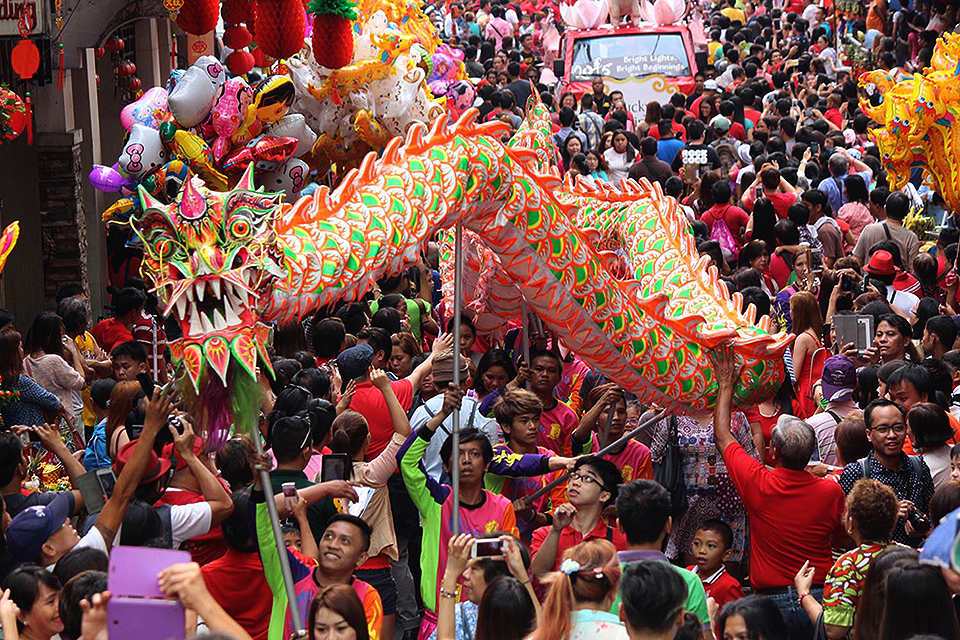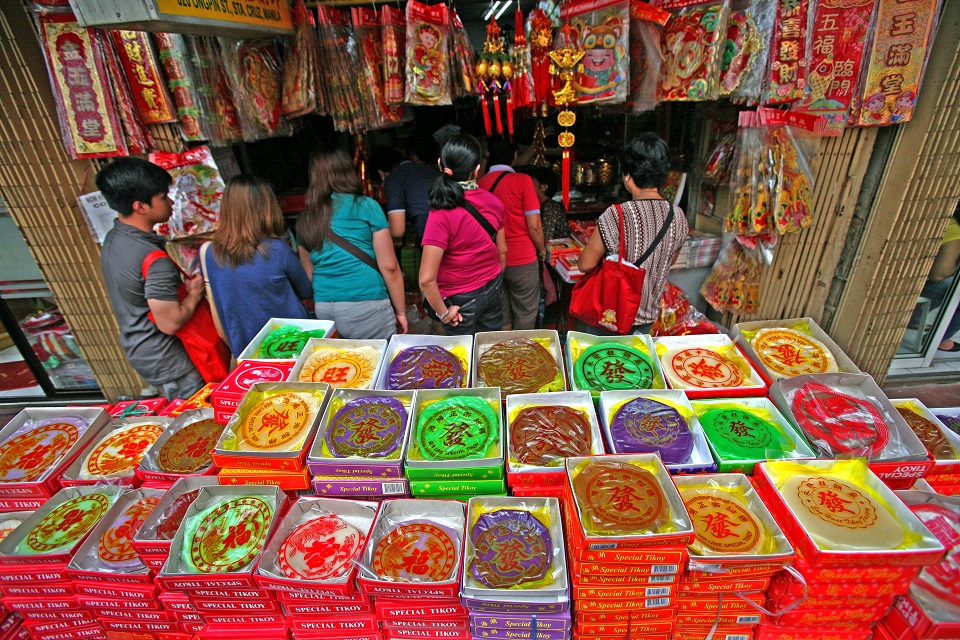Filtered By: Lifestyle
Lifestyle
‘Kiong hee!’: Chinese New Year celebrations, traditions in Metro Manila

Dragon dancers snake their way through a sea of people in Binondo, Manila during the Chinese New Year celebrations on Thursday, February 19. Roy Lozano
Here is how the Tsinoys of Metro Manila usher in the New Year.
A word on words
The majority of the Chinese in the Philippines are of Hokkien descent. Anthropologist and UP Diliman Chancellor Dr. Michael Tan noted in a Thursday News to Go video that “Kiong Hee Huat Tsai!” is the more appropriate New Year greeting, as opposed to “Kung Hei Fat Choi.” The latter is a Cantonese greeting, speculated to have been imported from America as there are more Canton Chinese there.
“Yung mga elderly na Chinese dito, inis na inis sila sa 'kung hei fat choi' na 'yan,” said Tan with a smile. He recommended using “kiong hee,” the short version of the Hokkien greeting, which means “wishing you happiness.” It can be used any time of year.
Lion vs. Dragon
No Lunar New Year would be complete without a lion or dragon dance. But what's the difference between the two?
“Yung lion dance, mas maliit siya. Madalas, pagsinasayaw ang lion dance, dalawang tao, isang ulo, isang buntot,” explained Old Manila Walks cultural guide Ivan Man Dy in a Balitanghali video Thursday.
Lion dances are accompanied by drums and cymbals. The lions are painted or sewn in bright colors, as the Chinese believe that bright colors attract more luck. It is also believed that lions ward off bad spirits, which is why they are figureheads of a dance.
As for the dance, the movements are considered a classic martial art, taking several years to perfect. Lion dancer Paolo Palo explained that the lion dance is very difficult, as one has to keep their eye on the footsteps and the hand movements in addition to being agile and flexible.
The dragon dance, Dy said, “mas mahaba, mas maraming tao. Kailangan mo ng mas malaking espasyo para isayaw ang dragon dance.”
Ten people or more must lift the dragon. Its body is made up of heavy poles, paper, and fabric. Dragon dancer Lander Palo said of participating in the dance, “Maswerte kasi, lalo na't pinapasok ito sa temple. Nabibigyan ng blessing yung dragon, pati na rin yung humahawak.”
In Chinese culture, dragons are believed to be luck-bringers. Dy said that a dragon embodies auspiciousness, as it once symbolized the emperor. Merchants put up red envelopes when dragons pass by for good luck and good health for themselves and their families.
Temple matters
The New Year is typically greeted with an explosion of noise—usually fireworks or drum-beating. Chinese culture has it that noise wards away bad luck.
But some families opt for quieter methods, such as going to Buddhist temples and monasteries to pray and meditate.
“Here in the monastery, we hope people come here to find their peacefulness in their mind,” said Master Jianquiang of Ocean Sky Monastery in a Saksi video Thursday.
People may offer flowers and incense or else drop coins at the small statues of the Enlightened Ones for luck all year round. Different offerings have different meanings:
- Flowers: change, hope
- Misua and siopao: long life
- Fortune buns: bountiful year
At a Taoist temple in Quezon City, meanwhile, others write their wishes on paper and burn the paper afterward. This symbolizes offering one's wishes up.
'You are what you eat'

Shoppers flock to a store in Binondo, Manila on Sunday, February 15, 2015, to buy tikoy and other food for the upcoming celebration of Chinese New Year on February 19. Danny Pata
“Kung kakain ka ng tikoy na malagkit, maging malagkit din ang mga relasyon mo—sa pamilya, sa boyfriend/girlfriend, sa asawa. That's why we give it to people, para maging close tayo,” said Tan.
Dishes take on an especial meaning at New Year's: they must be vegetarian, with no garlic, onions, chives or cilantro mixed in. Chef Joey Gayuma of Veggiezen explained that people who always eat those particular vegetables become hot-headed.
Meanwhile, round fruits bring in good luck, balance, and plentiness. The number you buy them in also counts for something: 8 is for everlasting luck, 12 is for the whole year, and 13 means your luck will spill over into another year.
Even drinks have a ritual attached. Drinking tea symbolizes cleansing the body and tempering the mind, thus ensuring a good disposition towards others.
“As we offer this cup of tea to the others, it also sends our blessings together in this cup,” said Abbess Miao Jing of Fo Guan Shang Mabuhay Temple.
Lucky symbols, charms
Binondo abounds with “lucky” items at this time of year, naturally. Among them count a life-sized fortune cat and a money tree with sheep figurines.
Wishing cranes are also popular—these are origami cranes in bright colors strung up and hanging from ceilings. In Chinese culture, having a thousand cranes means that one's wishes will come true.
Some of those in Binondo selling lucky charms made these items themselves. These beaded charms are specific to one's birth year, zodiac sign, and sign for this year. But the charms come in other forms as well: rooster and snake figurines, palay, suman, and palaspas.
Whether you are Filipino or Chinese or both, kiong hee! — Vida Cruz/BM, GMA News
More Videos
Most Popular




